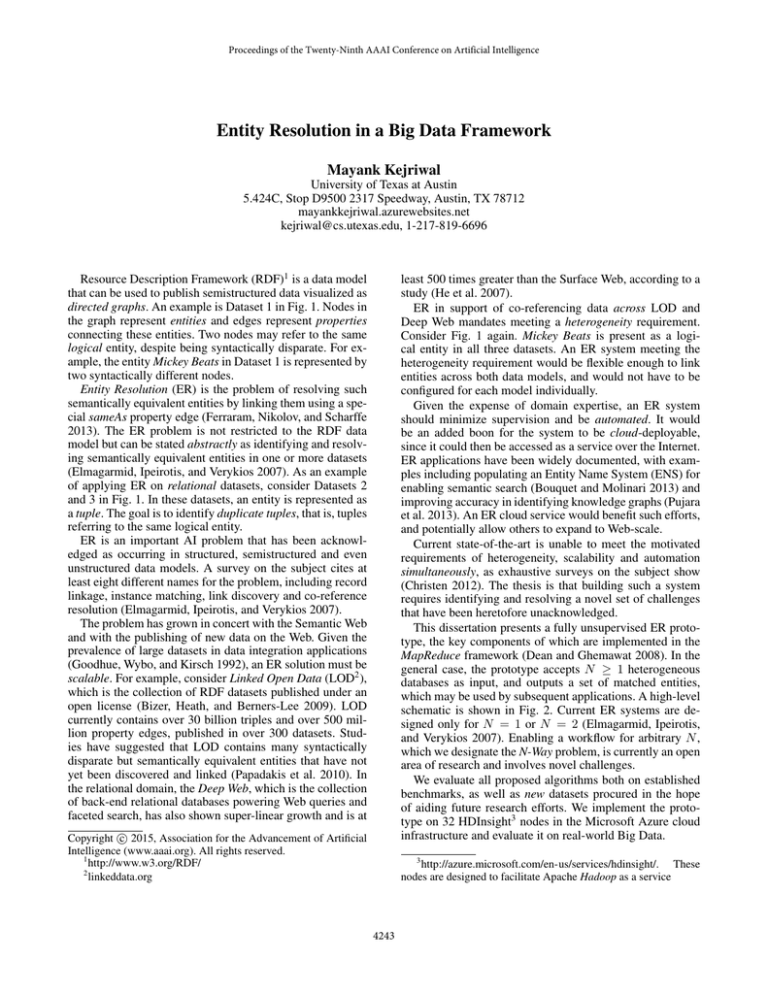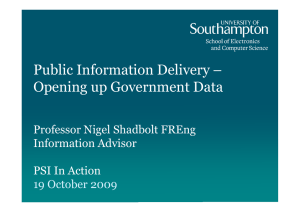
Proceedings of the Twenty-Ninth AAAI Conference on Artificial Intelligence
Entity Resolution in a Big Data Framework
Mayank Kejriwal
University of Texas at Austin
5.424C, Stop D9500 2317 Speedway, Austin, TX 78712
mayankkejriwal.azurewebsites.net
kejriwal@cs.utexas.edu, 1-217-819-6696
Resource Description Framework (RDF)1 is a data model
that can be used to publish semistructured data visualized as
directed graphs. An example is Dataset 1 in Fig. 1. Nodes in
the graph represent entities and edges represent properties
connecting these entities. Two nodes may refer to the same
logical entity, despite being syntactically disparate. For example, the entity Mickey Beats in Dataset 1 is represented by
two syntactically different nodes.
Entity Resolution (ER) is the problem of resolving such
semantically equivalent entities by linking them using a special sameAs property edge (Ferraram, Nikolov, and Scharffe
2013). The ER problem is not restricted to the RDF data
model but can be stated abstractly as identifying and resolving semantically equivalent entities in one or more datasets
(Elmagarmid, Ipeirotis, and Verykios 2007). As an example
of applying ER on relational datasets, consider Datasets 2
and 3 in Fig. 1. In these datasets, an entity is represented as
a tuple. The goal is to identify duplicate tuples, that is, tuples
referring to the same logical entity.
ER is an important AI problem that has been acknowledged as occurring in structured, semistructured and even
unstructured data models. A survey on the subject cites at
least eight different names for the problem, including record
linkage, instance matching, link discovery and co-reference
resolution (Elmagarmid, Ipeirotis, and Verykios 2007).
The problem has grown in concert with the Semantic Web
and with the publishing of new data on the Web. Given the
prevalence of large datasets in data integration applications
(Goodhue, Wybo, and Kirsch 1992), an ER solution must be
scalable. For example, consider Linked Open Data (LOD2 ),
which is the collection of RDF datasets published under an
open license (Bizer, Heath, and Berners-Lee 2009). LOD
currently contains over 30 billion triples and over 500 million property edges, published in over 300 datasets. Studies have suggested that LOD contains many syntactically
disparate but semantically equivalent entities that have not
yet been discovered and linked (Papadakis et al. 2010). In
the relational domain, the Deep Web, which is the collection
of back-end relational databases powering Web queries and
faceted search, has also shown super-linear growth and is at
least 500 times greater than the Surface Web, according to a
study (He et al. 2007).
ER in support of co-referencing data across LOD and
Deep Web mandates meeting a heterogeneity requirement.
Consider Fig. 1 again. Mickey Beats is present as a logical entity in all three datasets. An ER system meeting the
heterogeneity requirement would be flexible enough to link
entities across both data models, and would not have to be
configured for each model individually.
Given the expense of domain expertise, an ER system
should minimize supervision and be automated. It would
be an added boon for the system to be cloud-deployable,
since it could then be accessed as a service over the Internet.
ER applications have been widely documented, with examples including populating an Entity Name System (ENS) for
enabling semantic search (Bouquet and Molinari 2013) and
improving accuracy in identifying knowledge graphs (Pujara
et al. 2013). An ER cloud service would benefit such efforts,
and potentially allow others to expand to Web-scale.
Current state-of-the-art is unable to meet the motivated
requirements of heterogeneity, scalability and automation
simultaneously, as exhaustive surveys on the subject show
(Christen 2012). The thesis is that building such a system
requires identifying and resolving a novel set of challenges
that have been heretofore unacknowledged.
This dissertation presents a fully unsupervised ER prototype, the key components of which are implemented in the
MapReduce framework (Dean and Ghemawat 2008). In the
general case, the prototype accepts N ≥ 1 heterogeneous
databases as input, and outputs a set of matched entities,
which may be used by subsequent applications. A high-level
schematic is shown in Fig. 2. Current ER systems are designed only for N = 1 or N = 2 (Elmagarmid, Ipeirotis,
and Verykios 2007). Enabling a workflow for arbitrary N ,
which we designate the N-Way problem, is currently an open
area of research and involves novel challenges.
We evaluate all proposed algorithms both on established
benchmarks, as well as new datasets procured in the hope
of aiding future research efforts. We implement the prototype on 32 HDInsight3 nodes in the Microsoft Azure cloud
infrastructure and evaluate it on real-world Big Data.
c 2015, Association for the Advancement of Artificial
Copyright Intelligence (www.aaai.org). All rights reserved.
1
http://www.w3.org/RDF/
2
linkeddata.org
3
http://azure.microsoft.com/en-us/services/hdinsight/. These
nodes are designed to facilitate Apache Hadoop as a service
4243
Figure 1: An instance of heterogeneous Entity Resolution, with Mickey Beats needing to be resolved across 3 databases
to reach fruition only after the conference ends, after which
Proposed Contribution 2, a relatively open research area,
will become a full-time priority. I also expect to spend 3
months writing the dissertation and repeating experiments.
The principal project investigators on all described efforts
are myself and my advisor, Daniel P. Miranker. In papers describing completed work, we are currently the only authors.
I would also like to acknowledge a graduating Ph.D. student,
Juan Sequeda, for his generous expertise on Semantic Web
technology and data mapping at key points of the research.
Figure 2: The N-Way ER prototype developed in the thesis
References
Table 1: An overview of the criteria that contributions and
proposed work fulfill. A, H, G and S stand for Automation,
Heterogeneity, Scalability and the N-Way problem respectively
Work
Contribution 1
Contribution 2
Contribution 3
Proposed Work 1
A
Yes
Yes
Yes
Yes
H
No
Yes
No
Yes
S
No
No
Yes
Yes
N
No
No
No
No
Proposed Work 2
Yes
Yes
Yes
Yes
Bizer, C.; Heath, T.; and Berners-Lee, T. 2009. Linked datathe story so far. International journal on semantic web and
information systems 5(3):1–22.
Bouquet, P., and Molinari, A. 2013. A global entity name
system (ens) for data ecosystems. Proceedings of the VLDB
Endowment 6(11):1182–1183.
Christen, P. 2012. Further topics and research directions. In
Data Matching. Springer. 209–228.
Dean, J., and Ghemawat, S. 2008. Mapreduce: simplified
data processing on large clusters. Communications of the
ACM 51(1):107–113.
Elmagarmid, A. K.; Ipeirotis, P. G.; and Verykios, V. S.
2007. Duplicate record detection: A survey. Knowledge and
Data Engineering, IEEE Transactions on 19(1):1–16.
Ferraram, A.; Nikolov, A.; and Scharffe, F. 2013. Data
linking for the semantic web. Semantic Web: Ontology and
Knowledge Base Enabled Tools, Services, and Applications
169.
Goodhue, D. L.; Wybo, M. D.; and Kirsch, L. J. 1992. The
impact of data integration on the costs and benefits of information systems. MiS Quarterly 293–311.
He, B.; Patel, M.; Zhang, Z.; and Chang, K. C.-C. 2007.
Accessing the deep web. Communications of the ACM
50(5):94–101.
Papadakis, G.; Demartini, G.; Fankhauser, P.; and Kärger, P.
2010. The missing links: Discovering hidden same-as links
among a billion of triples. In Proceedings of the 12th International Conference on Information Integration and Webbased Applications & Services, 453–460. ACM.
Pujara, J.; Miao, H.; Getoor, L.; and Cohen, W. 2013.
Knowledge graph identification. In The Semantic Web–
ISWC 2013. Springer. 542–557.
Status
Done
Done
Done
4
months
6
months
A summary of completed and proposed contributions (as
of September, 2014) is presented as a matrix in Table 1. For
the proposed work, an approximate time frame for completion is indicated. Note that some of the contributions span
multiple publishable papers. An example is Contribution 2,
which adds heterogeneity to Contribution 1. In two separate
works, we apply our proposed techniques to different parts
of the ER pipeline for RDF inputs. One of these has been accepted for a workshop publication at ISWC4 , while the other
is currently pending as a regular paper at ACM SIGMOD.
For full details on all these publications, please refer to the
attached Curriculum Vitae. We also plan to integrate these
heterogeneity efforts into a December journal submission.
By the time of the AAAI conference, I expect to have
made refinements to Contribution 2 efforts, by way of multiple channels of feedback from reviewers and conference
attendees, and to have submitted a Contribution 3 paper to a
data mining conference. Considerable progress on Proposed
Contribution 1 is anticipated, but the full effort is expected
4
International
semanticweb.org
Semantic
Web
Conference:
iswc2014.
4244



